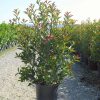July is the time to think about next spring, as well as time to separate any bulbs that you have. Always let the foliage die down and turn brown before you dig and thin out your bulbs. When growing bulbs you should plan on doing this every 3-4 years. It will increase the overall look of your garden, crowded bulbs produce fewer blooms that are smaller as well.
Plants that are planted in containers on your patio, around your pool or, on your front porch need to be watered more frequently with the higher temperatures during the summer months. This is also true for hanging baskets, which will dry out even faster with the summers hot, dry wind. Watering this often will wash out all of the plant food. Using a fertilizer that can be mixed with water will help to keep the plants color fresh and continuing to bloom.
Now is the time to do your final pinch on your fall blooming garden mums. This will help them to fill out and become bushy. Most varieties will begin to set buds next month.
Continue to remove seed heads from your blooming annuals, this will encourage them to continue to bloom. Plants with seeds left on will begin to stop blooming and start sending their resources to “feed the seeds.”
There are several choices for summer color. Bronze leaf Begonias for sun and Green leaf for shade will continue to bloom right up to fall. Periwinkles, Zinnias, Purslane, and Moss Rose (Portulaca) will all bloom straight through the hot summer months and into the fall. Also you can plant tropical color, such as hibiscus, bougainvillea, crotons, pentas, mandevilla, fire bush, and Mexican heather.
If you are planning a fall vegetable garden, now is a good time to decide what you might want to plant there and decide if there are any existing plants you would like to keep through the fall growing season. It will take some work to get them through the heat, but they will pay off in the fall garden. Plant tomatoes in July, Peppers (July-August), Eggplant (mid July to early August), Peas (July-early August), watermelon (July-Early August).
Now is the best time to treat for grub worms. Check a few places in your lawn, if your yard is spongy in areas when you walk across it dig a few holes around to see how many you find. Only treat your yard if you actually see grub worms present in your yard.
Chinch bugs love warm weather and will increase in numbers very quickly. Damage usually occurs during the hottest and driest parts of the year. There is no need to treat until the signs or the insects are present in the landscape.
Proper watering is very important, keeping the quality of your landscaped area well irrigated will help insure a healthy landscape. Always water deeply and infrequently to help encourage a deep root system versus a shallow one which requires water more often. Mulching at least 2 inches around all trees and shrubs and at least 1 inch around annual color will help to reduce the extra water required to keep them healthy as well as help keep the soil temperature down. Organic mulches work best and break down over time, benefiting your soil.
Always try to do any extensive landscape maintenance during the early morning, afternoon or late evening hours or on cooler days.


